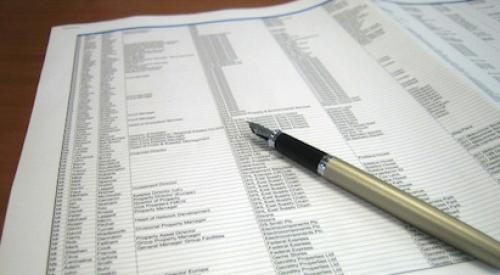Most builders recognize the importance of leveraging spending on direct materials such as concrete, lumber, and windows, and for installed services such as plumbing, electrical, and HVAC. But many overlook the opportunity to do so on back-office spending—in other words, any purchase that isn’t directly charged to building a house. Office supplies, computer software, wireless services, and waste removal are just a few. Procurement of these supplies and services is often decentralized and rarely competitively bid.
Just like direct-supply spending, back-office spending needs to be tracked on an opportunity matrix: a spreadsheet that identifies and tracks potential ways to reduce costs. Most builders can cut back-office spending without reducing the quality of the products and services they receive. Overall, expenditures are less, but the percentage savings are often a lot more. I’ve saved 30 percent and often more in some back-office spend categories (for a list, see the sidebar). You can too. Here’s how.
1/ Conduct a spending analysis
Pull together a list of all your indirect purchases for the last 12 months (LTM). If you don’t have a procure-to-pay (P2P) software application, consider getting one. In the meantime, pulling data will be a manual task. You’ll want a description of the product or service purchased, the supplier name, date of purchase, name of the person in your company who procured it, a copy of the most recent invoice, a copy of the contract (if you have one), a copy of the purchase order, and the GL account. Enter the data into a spreadsheet. A caveat: Organizing the data in this format may prompt the urge to tackle a category immediately. Hold off until you identify the highest and best use of your limited resources.
2/ Prioritize sourcing efforts
Add a column in your spreadsheet for the estimated savings percentage (ESP). Enter that percentage. You’re unlikely to know it exactly at this point, so start by entering 10 percent for all categories. Use the next column to multiply the category spending by the ESP. This new column will be your estimated savings dollars (ESD). Sort your spreadsheet using this column, with the largest opportunity at the top and the smallest at the bottom. Given the limited resources you likely have, allocate your time to working on those areas that will have the biggest return on the resources deployed. As you progress, you’ll be able to adjust the ESP and reprioritize the list. I even add additional columns to capture estimated resource hours required to realize the savings and ROI. It sometimes makes sense for me to work on two smaller categories because they can be completed quicker while providing a bigger aggregated ESD than a single, larger category.
3/ Take full advantage of available resources
Who is responsible for sourcing back-office materials and services? If you have a purchasing department, use this great resource to manage back-office spending. The sourcing steps to realizing savings in the back-office categories are similar to those used in the direct side of your business. The difference is, you have more resources (people working for your suppliers to minimize their back-office expense) available to you on the back-office side. For example, you could pull together those responsible for purchasing back-office products and services from your supply chain. If you’re doing business with any large suppliers, they likely have a specific person or team to manage their indirect or back-office sourcing. Chances are, they purchase some of the same products or services that you do. I’m not suggesting that you share pricing information—please don’t. Inquire about best practices for each indirect spend category. I once saved a company more than a million dollars annually by learning how one of its suppliers managed mobile device and wireless services. Rather than go with an expensive unlimited plan, the supplier used a less expensive plan that enabled it to share minutes across the entire company. It then monitored and adjusted plans as needed to avoid overage fees and maintain a buffer of minutes.
4/ Use fewer SKU numbers and fewer suppliers
How many different pencils, pens, printers, laptops, monitors, phones, etc., do you really need? Involve users and select standard SKUs based on cost and value received. Fewer SKUs will let your purchasing department leverage the volume for lower costs. You can also take advantage of larger orders in some instances to reduce inbound freight costs. Once you’ve reduced the SKUs, stick to them. Most suppliers will provide great pricing on the SKUs that you competitively bid, only to sell your users different products that have a higher margin. Review SKUs often and update as needed: It’s crucial for tech-related items. Anytime the SKUs change, there should be a sourcing event or at least a negotiation to assure you that you’re not being overcharged for the items.
5/ Reduce consumption
The best way to reduce costs is to avoid incurring them. Review expenses: Look for areas in which you are spending money but no longer getting the value that you once received. Examples include: magazines, newspaper or online subscriptions, memberships, etc. Look for ways to be more efficient. Examples include: Make sure there are no voids in your Dumpsters before they are pulled, close windows when the HVAC is running, turn outside lights off during the day, use LED bulbs in your model homes, track ROI on your marketing and advertising spend, eliminate unnecessary bank fees, take advantage of early payment discounts, etc. The list goes on and on. The point here is to first look to see if there are opportunities to eliminate a spend before you go and launch a sourcing event.
6/ Audit invoices for accuracy
Check the accuracy of the invoices you are paying. You may not have a contract or even a purchase order for your accounts payable department to go on. They often rely on someone in your company to approve the invoice. I’ve found that to be problematic if that person is not the one closest to the actual spend. This may sound crazy, but I’ve seen builders pay utility bills for months after they sold and turned over a model home to the owner occupant. I’ve seen builders pay for cell phones more than a year after they terminated an employee because there wasn’t a process in place to collect the device and terminate the service. I’ve also seen invoices with simple billing errors not caught because they were on every invoice. The method of continuing to pay an ongoing invoice based on it matching the prior month is not a good process; billing errors almost always benefit the supplier. Treat every invoice in a zero-based budgeting manner. Each should require review and justification as if it was the first invoice.
Want to learn about more ways to leverage back-office spending? Write me at tonyc@callahancg.com. PB
Tony Callahan is president of Callahan Consulting Group.
BACK-OFFICE EXPENSE CHECKLIST
Back-office spend is any expense that isn’t directly charged to a house. Here are common examples. How many are you monitoring?
• Advertising (print)
• Accounting and audit services
• Bank services
• Business cards
• Computer software
• Computer hardware
• Copiers
• Document shredding services
• Employment testing services
• Fax service
• Fleet maintenance
• Floor mat services
• Insurance
• IT services
• Marketing products
• Marketing services
• Model home maintenance
• Model home rent
• Office cleaning services
• Office furniture
• Office leases
• Outsourced training
• Phone service
• Printers
• Recruiting services
• Security services
• Small-parcel shipping
• Temporary labor
• Travel (hotel and rental cars)
• Utilities
• Waste disposal
EXPENSE-LEVERAGING CRIB SHEET
• Capture LTM spend
• Prioritize sourcing efforts
• Engage purchasing and large direct-spend suppliers
• Reduce SKUs
• Reduce consumption
• Reduce suppliers
• Use those closest to the spend to approve invoices
• Audit invoices in accounting
• Adopt technology (P2P software) to manage spending












